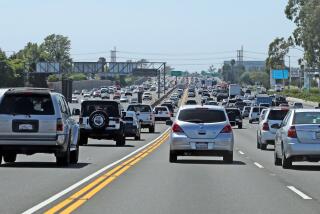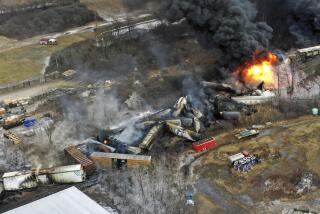This technology could prevent train crashes. So what are railroads waiting for?

Neil Brown, a mechanical systems manager with
- Share via
The crash of a Metrolink passenger train in California seven years ago that killed 25 people was caused by a devastating human error — the engineer missed a stop signal while texting on his cellphone — and Congress ordered a technological fix to ensure that such accidents never happen again.
The idea was to use global positioning satellites, sensors and sophisticated computers to track trains and prevent their crews from ignoring signals and speed limits. It was all supposed to be in place by the end of this year, but the railroad industry and government regulators will fail to meet the deadline by a wide margin.
The system is known as positive train control. Had it been operating on the northbound Amtrak line in Philadelphia this week, federal investigators say, it would have prevented the passenger train from accelerating to twice the posted speed limit and then derailing in a thunderous crash that left eight people dead and more than 200 injured.
“I can confidently say that an operational positive train control would have prevented this accident,” said Robert L. Sumwalt, a member of the National Transportation Safety Board, which is investigating the accident.
Across the U.S., fewer than 20% of the tracks scheduled for the new safety system have been equipped with it.
Safety experts, including former NTSB Chairman Jim Hall, say the railroad industry has dragged its feet and failed to make safety its top priority, though industry officials say they have been moving as swiftly as possible to phase in the new technology.
Edward Hamberger, president of the Assn. of American Railroads, said the delays have been caused chiefly by federal red tape, including a dispute between two federal agencies over jurisdiction for installing antennas. The technology that allows computers to intervene in the operation of thousands of trains all over the nation has also been challenging.
The delays are “not for lack of effort or lack of resources,” Hamberger said.
About half of the tracks in the Northeast corridor, the nation’s busiest, are equipped with the system on at least on one set of tracks, but it was not in place on the northbound curved section where the accident occurred. Amtrak officials said Thursday they would have the system on its entire Northeast corridor by the end of the year.
The nation’s largest freight haulers are expected to complete installation of $9 billion worth of control systems across the country by 2020. Two more years will be needed to test the system, placing the program about seven years behind schedule. A bill moving through the Senate would grant the industry an extension from the original requirement to have the safety system operational by December.
Hall said it would be possible to proceed more quickly if the industry were willing to make additional up-front expenditures. “They are looking at safety as a formula rather than a moral obligation,” he said.
Grady Cothen Jr., a railroad consultant and former Federal Railroad Administration official who worked on safety issues, said the system could be completed by 2018, because many of the technical problems have already been solved.
“There is no reason to reward the dilatory with more time than is necessary,” he said, suggesting Congress impose tough time limits.
Bill Keppen, a railroad safety consultant who’s spent years in the industry, said that while railroads were in no hurry to develop the control systems before the 2008 accident in Chatsworth, Calif., they have since then had “legitimate concerns about the cost and technical issues, such as reliability, acquiring enough bandwidth for communications systems and land acquisitions for communications towers.”
Proponents of positive train control have been waiting for decades. The NTSB recommended the system in 1976 after a Texas & Pacific Railroad engineer ran a stop signal in Meeker, La., and slammed into the rear of another freight train. In 1990, the agency added the technology to its list of most-wanted transportation safety improvements.
NTSB officials believe the automated system can prevent serious train accidents caused by crew fatigue, sleep disorders, inattentiveness and mistakes in judgment -- potential problems they said became more apparent with the Chatsworth catastrophe.
After the Metrolink engineer missed a stop signal while texting, the train slammed head-on into a Union Pacific freight train.
Metrolink, which serves six Southern California counties, is among the national leaders in developing positive train control and plans to have it installed months ahead of the federal deadline on Dec. 31. It already is in place on lines connecting Los Angeles to Ventura, San Bernardino and Lancaster.
“It’s being tested throughout the entire system and by summertime positive train control will be fully operational on all 512 miles of our track,” said Richard Katz, a longtime Metrolink board member. “It hasn’t been easy, but it has gone very well.”
After the Chatsworth crash, Congress passed the Railway Safety Improvement Act of 2008, mandating that the nation’s freight and passenger railroads be equipped with positive train control by the end of 2015. Originally, the FRA estimated the price tag would be just $2.3 billion for 100,000 miles of track. But Hamberger said the system for just 60,000 miles would cost the industry $9 billion.
U.S. Sen. Dianne Feinstein (D-Calif.) has been fighting to keep the 2015 deadline in place, against Republicans who want to grant a five- to seven-year delay. She contends that if Metrolink can comply with the requirement, other railroads can too.
“The railroad industry has been lobbying furiously to delay the mandate, Feinstein said this week. “In my view, that is extremely reckless policy.”
Follow Ralph Vartabedian @rvartabedian and Dan Weikel @LADeadline on Twitter
More to Read
Sign up for Essential California
The most important California stories and recommendations in your inbox every morning.
You may occasionally receive promotional content from the Los Angeles Times.












